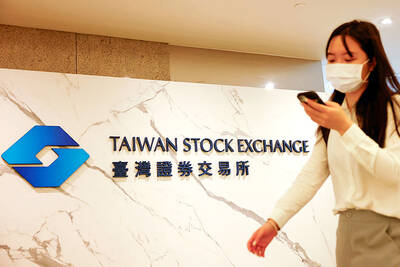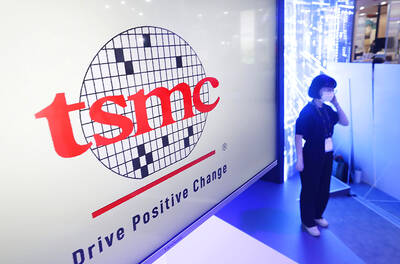Lite-On Technology Corp (光寶科技) yesterday reported a better-than-expected profit for last quarter.
Net profit grew 4 percent year-on-year to NT$1.7 billion (US$52.24 million), or earnings per share of NT$0.74, outperforming the market’s consensus estimate of NT$1.57 billion, or NT$0.67 per share.
However, last quarter’s figure plunged 32 percent from the prior quarter’s NT$2.5 billion, because of seasonal factors.
Due to a better product portfolio and operating efficiency, gross margin and operating margin were 13.2 percent and 4.1 percent in the first quarter respectively, an increase of 0.66 percentage points and 0.78 percentage points from a year earlier, Lite-On said.
“Last quarter was considered the bottom of the year and the overall business is forecast to pick up from this quarter,” Lite-On chief executive officer Warren Chen (陳廣中) told an investors’ conference at the firm’s headquarters in Taipei.
In the first quarter, consolidated revenue totaled NT$49.84 billion, down 3 percent annually and 14 percent quarterly, company data showed.
The electronics component maker’s cloud-computing business segment — including power supply units, casings for servers and storage — contributed as much as 10 percent to its first-quarter revenue.
“High-end power supply units for servers were the main growth driver for Lite-On’s cloud-computing segment last quarter,” Lite-On investor relations senior director Julia Wang (王玉玲) said.
In addition to robust demand from server brand names, such as HP Inc and Dell Inc, Lite-On also saw rising demand for high-end power supply units from self-built data center clients, Wang said.
The company’s LED business — which refers to LED modules and outdoor LED lighting products — sales also performed well in the first quarter, accounting for 10 percent of its total revenue.
However, weaker-than-expected demand for smartphones in the end-market last quarter dragged down Lite-On’s smartphone camera module (CCM) business, Chen said.
The weakness is likely to extend to this quarter before the CCM business rebounds in the second half of the year, Chen said, citing smartphone launches from new clients and an anticipated rising adoption of dual cameras for existing clients’ new products.
Overall, the company’s LED business revenue is forecast to increase from this quarter due mainly to increasing use of LED modules in smartphones, Wang said.
“The demand for LED flash is expected to grow in tandem with the increasing adoption of dual cameras used for high-end smartphones later this year,” Wang said.
In addition, steady growth in the LED streetlamp and automotive LED lighting businesses would also benefit Lite-On’s overall LED business, she added.

ADVANCED: Previously, Taiwanese chip companies were restricted from building overseas fabs with technology less than two generations behind domestic factories Taiwan Semiconductor Manufacturing Co (TSMC, 台積電), a major chip supplier to Nvidia Corp, would no longer be restricted from investing in next-generation 2-nanometer chip production in the US, the Ministry of Economic Affairs said yesterday. However, the ministry added that the world’s biggest contract chipmaker would not be making any reckless decisions, given the weight of its up to US$30 billion investment. To safeguard Taiwan’s chip technology advantages, the government has barred local chipmakers from making chips using more advanced technologies at their overseas factories, in China particularly. Chipmakers were previously only allowed to produce chips using less advanced technologies, specifically

BRAVE NEW WORLD: Nvidia believes that AI would fuel a new industrial revolution and would ‘do whatever we can’ to guide US AI policy, CEO Jensen Huang said Nvidia Corp cofounder and chief executive officer Jensen Huang (黃仁勳) on Tuesday said he is ready to meet US president-elect Donald Trump and offer his help to the incoming administration. “I’d be delighted to go see him and congratulate him, and do whatever we can to make this administration succeed,” Huang said in an interview with Bloomberg Television, adding that he has not been invited to visit Trump’s home base at Mar-a-Lago in Florida yet. As head of the world’s most valuable chipmaker, Huang has an opportunity to help steer the administration’s artificial intelligence (AI) policy at a moment of rapid change.

TARIFF SURGE: The strong performance could be attributed to the growing artificial intelligence device market and mass orders ahead of potential US tariffs, analysts said The combined revenue of companies listed on the Taiwan Stock Exchange and the Taipei Exchange for the whole of last year totaled NT$44.66 trillion (US$1.35 trillion), up 12.8 percent year-on-year and hit a record high, data compiled by investment consulting firm CMoney showed on Saturday. The result came after listed firms reported a 23.92 percent annual increase in combined revenue for last month at NT$4.1 trillion, the second-highest for the month of December on record, and posted a 15.63 percent rise in combined revenue for the December quarter at NT$12.25 billion, the highest quarterly figure ever, the data showed. Analysts attributed the

Taiwan Semiconductor Manufacturing Co’s (TSMC, 台積電) quarterly sales topped estimates, reinforcing investor hopes that the torrid pace of artificial intelligence (AI) hardware spending would extend into this year. The go-to chipmaker for Nvidia Corp and Apple Inc reported a 39 percent rise in December-quarter revenue to NT$868.5 billion (US$26.35 billion), based on calculations from monthly disclosures. That compared with an average estimate of NT$854.7 billion. The strong showing from Taiwan’s largest company bolsters expectations that big tech companies from Alphabet Inc to Microsoft Corp would continue to build and upgrade datacenters at a rapid clip to propel AI development. Growth accelerated for